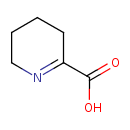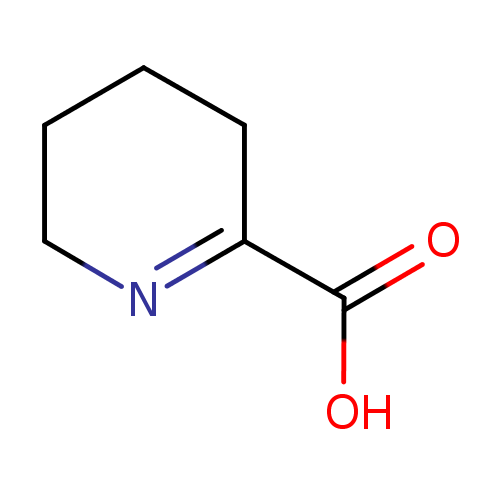|
Record Information |
|---|
| Version |
1.0 |
|---|
| Update Date |
1/22/2018 11:54:54 AM |
|---|
|
Metabolite ID | PAMDB120447 |
|---|
|
Identification |
|---|
| Name: |
Δ1-piperideine-2-carboxylate |
|---|
| Description: | A piperidinecarboxylate that is the conjugate base of 1-piperideine-2-carboxylic acid. |
|---|
|
Structure |
|
|---|
| Synonyms: | - 1,2-didehydropiperidine-2-carboxylate
|
|---|
|
Chemical Formula: |
C6H8NO2 |
|---|
| Average Molecular Weight: |
126.135 |
|---|
| Monoisotopic Molecular
Weight: |
127.06333 |
|---|
| InChI Key: |
GEJXSVNGWOSZPC-UHFFFAOYSA-M |
|---|
| InChI: | InChI=1S/C6H9NO2/c8-6(9)5-3-1-2-4-7-5/h1-4H2,(H,8,9)/p-1 |
|---|
| CAS
number: |
2756-89-0 |
|---|
| IUPAC Name: | 3,4,5,6-tetrahydropyridine-2-carboxylate |
|---|
|
Traditional IUPAC Name: |
1-piperideine-2-carboxylate |
|---|
| SMILES: | C1(N=C(CCC1)C(=O)[O-]) |
|---|
|
Chemical Taxonomy |
|---|
|
Taxonomy Description | This compound belongs to the class of chemical entities known as tetrahydropyridines. These are derivatives of pyridine in which two double bonds in the pyridine moiety are reduced by adding four hydrogen atoms. |
|---|
|
Kingdom |
Chemical entities |
|---|
| Super Class | Organic compounds |
|---|
|
Class |
Organoheterocyclic compounds |
|---|
| Sub Class | Pyridines and derivatives |
|---|
|
Direct Parent |
Tetrahydropyridines |
|---|
| Alternative Parents |
|
|---|
| Substituents |
- Tetrahydropyridine
- Ketimine
- Carboxylic acid derivative
- Carboxylic acid
- Monocarboxylic acid or derivatives
- Azacycle
- Organic 1,3-dipolar compound
- Propargyl-type 1,3-dipolar organic compound
- Carbonyl group
- Hydrocarbon derivative
- Organooxygen compound
- Organonitrogen compound
- Organic oxide
- Organopnictogen compound
- Imine
- Organic oxygen compound
- Organic nitrogen compound
- Aliphatic heteromonocyclic compound
|
|---|
| Molecular Framework |
Aliphatic heteromonocyclic compounds |
|---|
| External Descriptors |
|
|---|
|
Physical Properties |
|---|
| State: |
Solid |
|---|
| Charge: | -1 |
|---|
|
Melting point: |
Not Available |
|---|
| Experimental Properties: |
| Property | Value | Reference |
|---|
| Melting Point | Not Available | Not Available | | Boiling Point | Not Available | Not Available | | Water Solubility | Not Available | Not Available | | LogP | Not Available | Not Available |
|
|---|
| Predicted Properties |
|
|---|
|
Biological Properties |
|---|
| Cellular Locations: |
Not Available |
|---|
| Reactions: | |
|---|
|
Pathways: |
|
|---|
|
Spectra |
|---|
| Spectra: |
Not Available |
|---|
|
References |
|---|
| References: |
- Chang YF, Charles AK: Uptake and metabolism of delta 1-piperidine-2-carboxylic acid by synaptosomes from rat cerebral cortex. Biochim Biophys Acta. 1995 Aug 23;1238(1):29-33. [7654748 ]
|
|---|
| Synthesis Reference: |
Noguchi, Yuichi; Kanda, Kiyoo; Hosoda, Taku; Akiyama, Katsumi. D1-Piperidine-2-carboxylic acid isolation from fermentatin broth. Jpn. Tokkyo Koho (1971), 5 pp. |
|---|
| Material Safety Data Sheet (MSDS) |
Not Available |
|---|
|
Links |
|---|
| External Links: |
|
|---|


